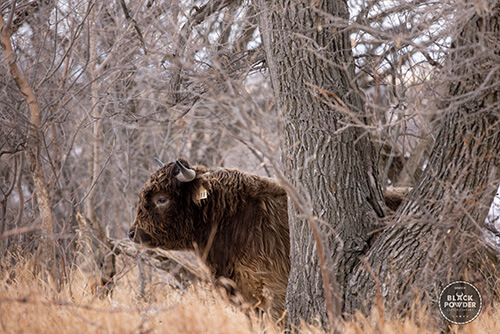Efficiency - Scottish Highlands are an incredibly efficient creature. They’re hardiness allows them to take rough forage and process it easily and seemingly effortlessly. While we have great pasture and hay, Highlands perform equally well in rougher environments with lower quality forage. It’s not uncommon for Highlands to be used to graze down fallow land so that it can be reclaimed as pasture or crop land.
Ease of calving - Calving can be stressful for animals and humans alike, and one of the things we quickly learned is that Highlands are great calvers. It’s uncommon to have to pull a calf from a Highland momma, and that takes a ton of pressure out of the equation for everyone involved.
Strong maternal instincts - It’s good to have momma cows that want to be momma cows and take great care of their calves. Highlands have a strong maternal instinct and create a nurturing and protective environment for their offspring. The result? Healthier, safer and happier calves.
Good against predators - Where we live, coyotes roam in abundance. While you can never guarantee that a predator won’t affect your livestock, Highlands have two very strong assets: the herd and the horns. A Highland fold sticks together under predator pressure, and when you have all those horns pointing toward an intruder, the safety of the livestock jumps considerably.
Cold weather resilience - we live in Canada, in the Prairies. Winters are cold and the wind amplifies that further. So, we wanted to make sure we raised a breed that wouldn’t just survive or tolerate the cold, but one that was comfortable in it. With their double coats, they stay warm even in the coldest temperatures and, at most, they like to have a bit of shelter or wind break in the winter. Also, while most cattle breeds begin to increase their feed consumption when the temperature hits 0 degrees C, Highlands don’t begin to increase their feed demands to stay warm until much colder temperatures.

Less prone to disease - In general, Highlands seem to be less prone to disease. Their long forelocks and eyelashes help protect their eyes from insects and the sun, reducing the risk of pinkeye and other eye-related diseases. They are also less prone to becoming stressed, and as a result, are less likely to have stress-related diseases.
Better meat - while taste is a personal preference, health is not and Highland meat is both healthy and delicious. Specifically, it’s a superior meat with lower fat content, lower cholesterol and a higher protein concentration. The perfect mix.
What we realized is that ultimately, Highlands respond well to how we want to raise cattle. We have a natural ranching philosophy where we’re keeping things as simple, healthy and enjoyable as possible - for us and the cattle! Nature usually shows us the way if we can pay attention and understand it - we’re doing our best to do exactly that with this fold.
Friendly, well-natured, good looking, easy to care for, easy to enjoy - Highlands were a perfect choice for our ranch and we think they would be for yours too.